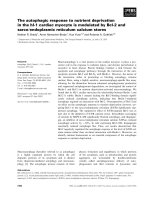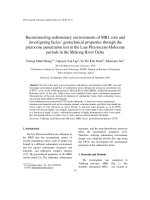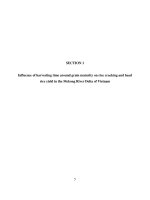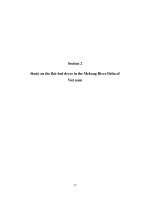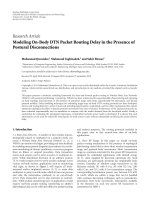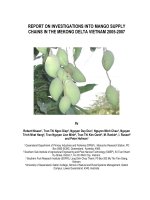Impacts of climate shock response measures on poverty vulnerability of farmer households in the Mekong river Delta
Bạn đang xem bản rút gọn của tài liệu. Xem và tải ngay bản đầy đủ của tài liệu tại đây (647.38 KB, 18 trang )
Tran Dai Nghia et. al. / Journal of Economic Development 23(3) 143-160
143
Impacts of Climate Shock Response Measures on
Poverty Vulnerability of Farmer Households
in the Mekong River Delta
TRAN DAI NGHIA
Institute of Policy and Strategy for Agriculture & Rural Development –
LE TRONG HAI
Institute of Policy and Strategy for Agriculture & Rural Development –
DOAN MINH THU
Institute of Policy and Strategy for Agriculture & Rural Development –
DINH PHI HO
University of Economics HCMC –
This research was funded by the National Fund for Scientific and Technology Development
(NAFOSTED) in the research No II6.1-2012.14.
ARTICLE INFO
ABSTRACT
Article history:
The analysis of this study is based on the inherited results using the
panel data of climate shocks and risks faced by farmers in 12
preventative provinces of the seven ecological regions of Vietnam as
surveyed by IPSARD (2013) and the data collected from the in-depth
studies with 330 farmer households sampled from six selected
provinces that represent five sub-ecological areas of Mekong River
Delta. The response probability models are employed to determine the
impacts of weather risks on incomes of the farmer households as well
as the effects of applying several climate change response measures
on poverty vulnerability of the farmers. As shown by the analytical
results, the poor household group is most impacted by the natural
risks, which in turn also affects the level of their poverty vulnerability.
To mitigate the negative impacts of extreme weather events, farmers
have proactively applied different responsive measures designed to
improve their resilience to climate and natural risks, such as changing
crop or animal varieties, changing farming patterns, and improving
production infrastructures. These measures are found to have
contributed significantly and effectively in preventing productivity
decline and mitigating income losses and therefore the farmers’
poverty vulnerability.
Received:
Feb. 26 2016
Received in revised form:
Mar. 15 2016
Accepted:
Jun. 20 2016
Keywords:
climate change, poverty,
vulnerability, farmer,
income reduction.
144
Tran Dai Nghia et. al. / Journal of Economic Development 23(3) 143-160
1. Introduction
Vietnam has gained rapid economic growth and impressive achievements in poverty
reduction over the past two decades. However, the development is now at risk of being
seriously affected by the impacts of climate change (McElwee, 2010). A range of local
and international researches has ranked Vietnam as one of the most severely affected
countries by climate change’s impacts (MONRE, 2010). World Bank (Technical report,
2008) has put Vietnam on the list of 12 countries that are most vulnerable to climate
change.
Vietnam has quite varied terrain with three fourths of its area being upland and hilly
(Vietnam Government, 2013). Hilly terrain with a long coastline and its location in the
center of the tropical storms cause the country to be easily affected by sea level rise and
extreme weather events such as floods, landslides, and heavy rain. Besides, since
agriculture accounts for 21% of GDP (GSO, 2013) and 48.4% of total workforce (GSO,
2012), climate change will also strongly influence several different aspects of farmers’
lives such as income, livelihoods, poverty, the inequality of income, vulnerability, and
health and nutrition. This research examines the impacts of some climate change
response measures on poverty vulnerability of the farmer households.
2. Theoretical bases and methodology
2.1. Literature review
According to the National Strategy on Climate Change (2011), Vietnam is considered
one of the countries severely affected by climate change, and the Mekong Delta is one
of the three plains in the world being the most vulnerable due to sea level rise besides
the Nile Delta (Egypt) and the Ganges Delta (Bangladesh). Strongly influenced by the
climate change are many aspects of famers’ lives such as income, likelihood, poverty,
inequality income, vulnerability, health, nutrition, and so on.
So far numerous researches and studies on the impacts of climate change and farmers’
responses to those impacts have been done, applying different approaches, methods, and
instruments. From 2004 to 2011, a series of works on these were published in Vietnam.
World Bank (2010) conducted a research with the focus on social dimensions of
adaptation to climate change and the aims to: (i) identify social vulnerability and
adaptive capacity in climate-change-affected regions of Vietnam and of vulnerable
Tran Dai Nghia et. al. / Journal of Economic Development 23(3) 143-160
145
people; (ii) establish a dataset to analyze and provide advice for the overall EACC study
on the role of social assessment to clarify the issues of vulnerability, adaptation, and
economic costs. Some of the methods applied in the study such as community risk
mapping, focus groups discussion, and key stakeholder and semi-structured interviews
were suitable for the case study.
Poverty reduction is another issue that arouses concern over analyses of farmers’
responses to climate change. Oxfam (2008), in his research in Ben Tre and Quang Tri
provinces, recommended that poor women’s and men’s needs and interests must be at
the heart of national and local research and policy planning on adaptation. The research
methodology of this study is also appropriate for case studies.
In another project conducted by Few et al. (2006), they approached the climate
change problem from a poverty reduction perspective besides further details on the
following: (i) how and under which conditions can current disaster risk management
practices help prepare for climate change; (ii) under which circumstances does climate
change require changes in disaster risk management approaches; and (iii) what lessons
can be learnt from the exercise that could inform wider adaptation policy. The paper
used a series of recommendations, drawn from input to the Vietnam country study,
feedback from country experts, and an international VARG workshop in Geneva,
Switzerland. The authors, considering multi-hazard and cross-sector aspects, proposed
several recommendations with an emphasis on a series of means which facilitate the
connection of climate change and disaster control practices in association with poverty
alleviation.
Moreover, several studies tend to focus on the climate change in agro-ecological
regions of Vietnam. In his research Britta Heine (2009) gathered successful approaches
and lessons to develop a guideline of adaptation to climate change in coastal areas of the
Mekong River Delta. The study provided concepts and methods for planning and
implementing farmer adaptation in three provinces (Soc Trang, Kien Giang, and Bac
Lieu), and then put forward implications for better adaptation to the climate change in
coastal areas such as focusing on mangroves and small‐scale aquaculture in the
mangrove forest areas.
Asian Disaster Preparedness Center (2003) demonstrated that poverty and lack of
capacity to address climate change and variability would increase the risk of disaster to
the Vietnamese population. On the other hand, the paper suggested better responses to
146
Tran Dai Nghia et. al. / Journal of Economic Development 23(3) 143-160
climate change in the Mekong Delta such as crop diversification and aquaculture-based
industrial ventures, which could provide capital for developing agro-industry and
accelerate the industrialization process in the region. Gradually, large numbers of
Mekong River Deltal workers will be shifted from high-risk coastal areas to other
industries, and then free the land for managrove cultivation.
There is also a variety of international researches on effects of climate change on
farmers and their responses in recent years. Lasco et al. (2011) pointed out its impacts
on agriculture and lives of the farmers with small-scale production. In particular, not
only do small-scale farmers suffer climate change impacts significantly on crop yields,
crop diseases, livestock, and water pollution but they are also vulnerable to risk of
climate change. The study cited previous researches and indicated that an “adaptation
gap” might exist in case of insufficiently implemented adaptation strategies, and
consequently, it results in increased levels of negative impacts of natural disasters in the
world recently. The study answered the question of what practices small-scale farmers
may adopt for their climate change adaptation. A series of solutions was mentioned,
including: (i) changing variety; (ii) changing crops and livestock, and cultivation time;
(iii) changing agricultural management; (iv) diversifying sources of incomes and
economic activities; (v) implementing carbon emission trading schemes; and (vi)
improving linkage with community organizations. This is an up-to-date study on
farmers’ responses to climate change, which, however, reflects a lack of a basic theory
and quantitative models.
The World Bank and FAO (2011) reached a better understanding of the issues and
options at the frontier of agricultural adaptation to climate change, identifying the
impacts and adaptation strategies and practices and exploring approaches to mainstream
climate change in development programs. Study results are summarized from the World
Bank’s conference results about mitigating the impacts of climate change and enhancing
food security. Adaptation measures are urgently required to increase the overall
flexibility of the agricultural systems against climate shocks and changing market
demands. Possible adaptation solutions include: (i) modification of farming practices;
(ii) diversification and development of new and more climate-induced stress resistant
crop varieties; (iii) improved soil conservation and water resources management; (iv)
supplementary and improved irrigation systems; (v) development of monitoring and
early warning systems; (vi) better use of risk transfer mechanisms; and (vii) an enabling
policy environment.
Tran Dai Nghia et. al. / Journal of Economic Development 23(3) 143-160
147
Gbetibouo (2009), for the first time in his research pursuit, applied the “bottom-up”
approach in order to find out farmers’ responses to climate change. The database of this
study was collected from 794 households in the Limpopo Basin of South Africa during
2004–2005. The study examined the level of farmers’ awareness in accordance with the
weather data collected by meteorological stations, as well as analyzed the farmers’
responses to climate and weather changes. Using Heckman probit and multiple logit
models, this research sought to examine the elements of adaptation to climate change.
Its statistical analysis of climate data showed the year-by-year increase in temperature
and change in rainfall. Despite being in line with the climate data reports, the results
suggested that only about half of the farmers had adjusted their farming activities to
respond to the climate change impacts. Lack of access to credit was a major factor that
limited the adaptation. The results of the multiple choice logit and Heckman probit
models emphasized that farmers’ scale, farming experience, wealth, access to credit,
access to water, the right to ownership, non-farm activities industrial, and agricultural
extension approach are essential to improved adaptability. Based on such, it was
proposed that the South African Government should design policies for better
improvements in these factors.
2.2. Analytical framework and methods
The research was conducted on the ground of the following analytical framework.
Impacts of climate shocks on poverty
Factors affecting farmers’ choices of
vulnerability of farmers
response measures
Response measures selected
Effects of applying selected response
measures on poverty vulnerability
Figure 1. Analytical framework of the research
148
Tran Dai Nghia et. al. / Journal of Economic Development 23(3) 143-160
The analysis was drawn from inherited results using the panel data of climate shocks
and risks encountered by farmers in 12 preventative provinces of the seven ecological
regions of Vietnam as surveyed by IPSARD (2013). The data were also collected from
the in-depth studies with 330 farmer households sampled from six selected provinces
that represent five sub-ecological areas of Mekong River Delta. These provinces are
most affected by the climate change in Vietnam, and to estimate this, we adopt
multistage cluster sampling technique (Ahmed, 2009). In order to control for data
reliability and validity as well as measurement and sampling errors, we use a number of
tests and measurements. After the data collection process, several tests are employed to
ensure unbiased estimates. These tests include testing for normality of residuals using
the One Sample Kolmogorov-Smirnov test. The results suggest that some variables do
not conform to the assumption of the regression analysis such as normality of the data.
The data that violate the normality assumption are then transformed with the use of
natural logarithms (Sheskin, 2004). Outliers whose observations have large residuals are
removed from the analysis whereby cases with studentized residuals greater than the
absolute value of 2 are excluded (Shuwu, 2006). In this research, Hadi’s (1992) method
is used to identify outliers at the 5% level of significance (default in Stata. 12). The
Variance Inflation Factor (VIF) procedure used to detect multicollinearity is preferred
to the correlation coefficient method, which fails to yield conclusive results (Pindyck &
Rubinfield, 1981). If the VIF is greater than 10, then there is a potential multicollinearity
problem (Neter et al., 1989). Following such, we accordingly detect no serious
collinearity problem among the independent variables. The latter test for homogeneity
is conducted using the Breusch-Pagan/Cook-Weisberg test for heteroskedasticity (Stata,
2007), and the null hypothesis of constant variances for residuals is accepted (p > 0.000).
The correction for heteroskedasticity involves standardizing variables (by dividing every
variable by its standard deviation) as suggested by Varian (1984) and Kuosmanen et al.
(2007) before the actual regression analysis can be done.
Table 1
Descriptive statistics of the surveyed households in Mekong River Delta
Variable
Obs.
Mean
Std. dev.
Min
Max
Age of household head (year)
330
53
12
28
92
Schooling time (year)
330
6.1
3.3
0.0
16.0
149
Tran Dai Nghia et. al. / Journal of Economic Development 23(3) 143-160
Variable
Obs.
Mean
Std. dev.
Min
Max
Gender of household head (=1 if male;
=0 otherwise)
330
0.8
0.34
0.0
1.0
Occupation (=1 if full-time farmer, =
0 otherwise)
330
0.87
0.33
0.00
1.00
Affiliation*
330
4.1
1.32
1.0
5.0
Family size ( persons)
330
4
1
1
8
Agricultural land (ha)
330
3.07
3.77
0.12
20.5
Rice cultivation area (ha)
191
1.97
2.53
0.63
20.5
Shrimp farming area (ha)
88
3.02
2.63
0.05
18.2
Fish farming area (ha)
20
1.71
1.99
0.01
5.5
Rice yield in winter-spring crop
(tone/ha)
191
6.9
1.94
0.54
13.0
Value of rice production (million
VND/HH/year)
191
170.6
202.8
20
1074
HH applied changing variety (=1 if
changed, = 0 otherwise)
330
0.71
0.45
0
1
HH applied ICM (=1 if changed, = 0
otherwise)
330
0.68
0.46
0
1
HH applied ICM (=1 if changed, = 0
otherwise)
330
0.79
0.40
0
1
Source: data retrieved from authors' calculations using the surveyed data in 2014.
*This variable is measured using Likert's scale (= 1 if not a member of any social/mass organization;
=2 if a member of one organization, = 3 if a member of two different organizations, = 4 if a member
of three different organizations, and =5 if a member of more than four different organizations).
The data in Table 1 show that rice cultivation is a main agricultural production in the
studied area, and it is followed by shrimp and fish (Tra fish) production. The farmers
interviewed are experienced ones aged 53 on average. Most of the household heads are
male, whose education levels are quite low (average of 6.1 years of schooling). Farmers
quite proactively applied different climate risk response measures (average of all three
responding measures of 0.68–0.79 in the scale of 1).
150
Tran Dai Nghia et. al. / Journal of Economic Development 23(3) 143-160
2.2.1. Assessing effects of climate change on productivity, poverty situation, and
social differentiation
The economic model to identify correlation between effects of climate change on
productivity, income, and poverty situation, is given by:
𝑦𝑖 = 𝑎0 + 𝑎1 𝑋1𝑖 + 𝑎2 𝑋2𝑖 + 𝑎3 𝑋3𝑖 + 𝑎4 𝑋4𝑖 + 𝑢𝑖
where Yi is the dependent variable, including income, productivity (yield), and poverty;
X1i, X2i, X3i, and X4i are vectors of the explained variable to represent: (i) observable
effects of climate change; (ii) observable household characteristics; (iii) observable
socio-economic characteristics of households; and (iv) observable local characteristics;
𝑢 is random with mean value equal to zero and variance equal to δ2; and i is the ith
observation.
The main steps to assess the impacts of climate change on social differentiation
among farmers are as follows:
Step 1: Identify required measures of inequality of income index, including Gini
index and Theil index and top-down rates of 10%–20%
Step 2: Calculate the inequality coefficient based on household survey data
Step 3: Identify scenarios in which impacts of climate change on famers’ poverty
vulnerability are estimated in monetary value, and calculate inequality coefficients of
these scenarios
Step 4: Compare inequality coefficients before and after the “climate change impact”
2.2.2. Assessing poverty vulnerability
The household data were surveyed by Institute of Labour Science and Social Affairs
(ILSSA) and Institute of Policy and Strategy for Agriculture and Rural Development
(IPSARD) funded by DANIDA from 2006 to 2012. This survey was further in-depth
studies of selected issues on Vietnam household living standards conducted by General
Statistics Office of Vietnam in 12 provinces1. In particular, the survey data provided
information on shocks and risk of farmers. The possibility that a farmer’s consumption
level (income) fell below a certain level due to shocks caused by climate change or
extreme weather phenomena was estimated as an alternative approach for measuring
poverty vulnerability.
According to Chaudhuri et al. (2002), the random process creating the consumption
of a household is defined by:
Tran Dai Nghia et. al. / Journal of Economic Development 23(3) 143-160
lnCh = Xhβ + eh
151
(1)
where Ch is the consumption per capita, Xh represents a group of household’s
characteristics (household size, location, educational level of household head, etc.) and
climate shocks (drought, floods, hail, and salinity intrusion), β is the parameter vector,
and eh is random error with its mean of zero and followed normal distribution.
The logarithm of the expected consumption and variance of the logarithm of the
household’s income reduction h can be estimated using estimated values of β and θ as
below:
𝐸̂ [lnDinch|Xh] = Xh𝛽̂
(2)
^2
𝑉̂ [lnDinch|Xh = 𝜎𝑒,ℎ
= Xh𝜃 ̂]
(3)
The consumption is assumed to have a normal distribution log (lnDinCh). We
estimate the probability that the household with characteristic Xh is a poor one if (.)Φ
shows the cumulative probability density in normal conditions, which is determined by:
̂ℎ = 𝑃𝑟
̂ (lnCh< lnz| Xh) = Ф((𝑙𝑛𝑧 − 𝑋ℎ𝛽 ̂)/√(𝑋ℎ𝜃 ̂ ))
𝑉
(4)
in which lnZ is the log of the minimum income, and if the household’s income is lower
than that level, then it could be considered vulnerable.
2.2.3. Analyzing the effects of applying different response measures on poverty
vulrability
The results of analyzing the impacts of climate change (extreme weather events) on
farmers' income and poverty vulnerability and those of analyzing the effects of adopting
different climate change response measures on mitigating production decline and
income losses are then incorporated into Eq. 1 to predict the impacts of climate change
on farmers' income by 2030 under different climate change scenarios and also to decide
on the fundamentals of farmers’ proactively taking climate change response measures in
the Mekong River Delta.
The 330 farmer households chosen to be surveyed represent those in the Mekong
River Delta, selected from the six provinces of five sub-ecological regions.
Selection of the surveyed farmers for the in-depth studies is based on the multistage
cluster sampling technique2.The provinces selected include: (i) the alluvian area along
and between the Tien and Hau Rivers (An Giang and Can Tho provinces); (ii) Long
152
Tran Dai Nghia et. al. / Journal of Economic Development 23(3) 143-160
Xuyen quadrangle (Kien Giang province); (iii) Plain of reeds (Long An province); (iv)
Coastal belt areas (Ben Tre province); and (v) Ca Mau peninsula (Soc Trang province).
3. Results and discussion
3.1. Impacts of climate risks (climate change) on income and poverty vulnerability
of farmer households
Table 2 shows that although the number of households experiencing risks falls, the
percentage of the households who experienced income reduction increases due to the
impacts of extreme weather events is revealed in some areas, becoming more serious
than before. The income losses caused by climate risks account for about 50% of total
income losses caused by all types of risks faced by the farmer households. Thus, the
measures aiming at strengthening coping capacity during extreme weather events will
significantly contribute to mitigate their negative impacts on farmers’ income.
Table 2
Income loss proportion by risks
2006
2008
2010
2012
Total losses in income
60%
25%
12%
15%
Income group 1*
89%
36%
16%
19%
Income group2
45%
22%
11%
17%
Income group3
34%
16%
9%
11%
Natural disasters
50%
68%
48%
30.9
Floods, typhoons, v.v.
24%
34%
20%
8.6
Diseases
26%
35%
28%
13.4
Damage rate by risks:
Source: data analyzed from the survey results of CAP, CIEM, ILSSA, 2013
Notes: samples are only households affected by risks.
*Income groups 1, 2, and 3 denote low income, average income, and high income households
respectively.
The results of Table 3 indicate that the low income group (Group 1) has the highest
percentage of income loss; therefore, households in the poorest group become more
153
Tran Dai Nghia et. al. / Journal of Economic Development 23(3) 143-160
vulnerable and easy to return to poverty if they are exposed to the risks and incur income
losses.
Table 3
Fixed effects on the impact of income risks on household’s assets
Risks considered
Income risks
(1)
(2)
(3)
(4)
-0.027
-0.028
(.563)
(0.351)
-0.188*
-0.189*
(0.081)
(0.067)
-0.153***
(0.000)
External risks
-0.092*
(0.087)
External risks: natural
External risks: economic
Source: analysed from the survey’s result of CAP, CIEM, ILSSA, 2013
Notes: Standard errors are grouped according to the recorded household level in parentheses (.). ***:
The level of significance at 1%, **: the level of significance at 5%, *: the level of significance at 10%.
Column (1): Negative impact on accumulation of the total of current assets. Column (2): Negative
impact on current asset value. Column (3): The reduction of the total of current asset value overtime.
Column (4): Impact on current asset volume.
3.2. Effects of adopting different climate change response measures on poverty
vulnerability of the farmers
The analytical results obtained from linear probability model suggest that climate
change and extreme weather events lead to reduced income and thus affect the
accumulation of the total household’s current assets and increase poverty vulnerability
of households. However, climate risks have no statistically significant effect on the
reduction of the total current assets over time or influence on the current asset volume.
The analytical results of the impacts of climate change response measures adopted by
farmers as represented in Table 4 show that for rice production in Mekong River Delta,
changing rice varieties toward having shorter duration and better disease tolerance or
resistance (Column 1) and changing crop patterns to avoid early draught or late flooding
(Column 2) in order to minimize the impacts of flooding and salinization (caused by
long draught condition) are two measures that have statistically significant contribution
154
Tran Dai Nghia et. al. / Journal of Economic Development 23(3) 143-160
in mitigating income losses due to reduction in rice productivity. Meanwhile, for corn
production, only changing crop patterns has significant impact on mitigating the income
losses resulting from extreme weather events. Changing crop varieties can contribute to
minimizing income losses in rice production by more than 18% (coefficient of -0.183),
and changing crop patterns can mitigate income loss by about 4% in rice production and
7% in corn production. Different climate change response measures have no statistically
significant effects on mitigating climate change impacts in fruit tree production. Given
livestock and fisheries, the measures that produce statistically significant effects on
mitigating loss involve adjusting stocking time and reinforced embankments and
drainage system in fish and shrimp farming. For pig and cattle raising, their effects are
not clear. The adjustment of stocking time based on early harvesting in the areas close
to rivers and coastal areas before the flooding season can mitigate by up to 17% of
income losses caused by extreme weather events in fish farming and 9% of those in
shrimp farming.
Thus, proactive measures to respond to climate change such as changes of crop
structure and animal varieties toward more resilience to extreme weather events and
diseases as well as changes of crop patterns are suggested to make significant
contribution to (or have statistically significant effects on) reduced income losses and
therefore poverty vulnerability of farmer households, who have been facing with
negative climate change impacts in their production.
Table 4
Effects of selected adaptation measures against reducing income losses caused by
extreme weather phenomena in agricultural production
Income reduction
caused by extreme
weather events
(Lndinc)*
Rice production
Coefficients reflecting the effect of the adaptation measures adopted
to cope with extreme weather events
M1
M2
-0.183***
-0.036*
(0.001)
(0.0571)
M3
M4
-0.007
-0.132
-0.072*
Corn production
-0.051
(0.0693)
0.071
0.214
Fruit tree plantation
0.002
-
-0.022
-0.008
155
Tran Dai Nghia et. al. / Journal of Economic Development 23(3) 143-160
Income reduction
caused by extreme
weather events
(Lndinc)*
Coefficients reflecting the effect of the adaptation measures adopted
to cope with extreme weather events
M1
M2
M3
M4
Pig raising
0.031
-
-0.003
0.214
Cattle production
0.011
-
0.031
0.017
(0.0452)
0.009
0.017
-0.091**
- 0.061*
(0.0718)
(0.0584)
-0.172**
Fish farming
0.007
Shrimp farming
0.217
0.038
Source: results of the survey conducted in six provinces of Mekong River Delta, 2014
Notes: Lndinc is the natural logarithm of the decreases in income in agricultural production activities
due to impacts of extreme weather (thousand VND/ha/year).
*, **, and *** denote the levels of statistical significance of 10%, 5%, and 1% respectively.
M1 (adaptation measure 1): using crop/animal varieties with
tolerance/resistance/resilience capacity when exposed to the extreme weather
better
M2 (adaptation measure 2): changing crop/animal patterns (earlier or later) to ease or
escape the extreme weather
M3 (adaptation measure 3): strengthening/improving production infrastructures to better
resilience when exposed to the extreme weather
M4 (adaptation measure 4): improving crop/animal management practices for greater
coping capacity of plants/animals under extreme weather conditions
Table 5
Effects of applying different climate change response measures on mitigating production
losses in terms of different CC scenarios by 2030
Production
affected
Extreme
weather
The yield reduction by 2030 under different climate change
scenarios* (% as compared to the surveyed amount in 2014)
B1
Response measure
M0**
M1
B2
M2
M0
M1
A2
M2
M0
M1
M2
156
Tran Dai Nghia et. al. / Journal of Economic Development 23(3) 143-160
Production
affected
Extreme
weather
The yield reduction by 2030 under different climate change
scenarios* (% as compared to the surveyed amount in 2014)
B1
Rice
Fish
farming
A2
Prolonged
draught
3.3
2.7
3.2
4.9
4.0
4.7
6.5
5.3
6.3
Flooding
2.6
2.1
2.5
3.9
3.2
3.8
5.2
4.2
5.0
Unusual
storms
13.4
-
11.1
20.1
-
16.6
28.8
-
23.8
Flooding
3.3
-
2.7
4.9
-
4.1
5.2
-
4.3
M0
M2
M3
M0
M2
M3
M0
M2
M3
Unusual
storms
4.2
3.8
3.9
6.3
5.7
5.9
8.4
7.6
7.9
Prolonged
heating
5.8
5.3
5.4
8.7
7.9
8.2
11.6
10.5
10.9
Response measure
Shrimp
farming
B2
Notes: * climate change scenarios developed by MONRE (2012)
** no climate change adaptation measures applied
The results of analyzing the impacts of climate change on farmers’ poverty
vulnerability and the effects of farmers’ different adaptation measures to cope with
extreme weather events are then incorporated into three main climate change scenarios
(B1, B2, A2)3 updated by MONRE (2012) along with the overall effects as displayed in
Table 5. The results in Table 5 show that proactively applying different climate change
response measures contribute significantly to mitigating income losses faced by the
farmer households and therefore relaxing their poverty vulnerability. Although the three
applied response measures have proved to play a vital role in reducing income losses,
the projected income losses under applying different response measures and climate
change scenarios by 2030 are still quite large. These results illustrate that the currently
applied response measures4 have still been far from sufficiency in allowing farmers to
Tran Dai Nghia et. al. / Journal of Economic Development 23(3) 143-160
157
minimize the negative impacts of climate change on their production and income and
thus on their poverty vulnerability.
4. Conclusion and policy implications
4.1. Conclusion
Climate risks as faced by farmers accounted for proximately 50% of the income
reduction, and the low-income (poorest) group of farmer households is most affected
and also most vulnerable to the impacts of climate change and extreme weather events.
The response probability model shows that the impacts of natural disasters and
climate change reduce income levels, thereby affecting the accumulation of households‘
current assets and increasing their poverty vulnerability. This is because when facing
risks, farmers either lost their income or had to use parts of their current assets to recover
the damages caused by the risks.
Proactive measures to cope with climate change such as changing crops and animal
varieties and changing crops and animal cultivating patterns toward more resilience to
climate and natural risks should be significantly contributed to mitigating income losses
and therefore the poverty vulnerability of farmer households that have been resisting its
negative impacts.
Although the currently applied climate change response measures have helped
considerably reduce income losses and levels of farmers' poverty vulnerability, the
projected income losses under the adaptation of different response measures in the three
main climate change scenarios (B1, B2, and A2) in 2030 are still quite large. This
illustrates that they have still been far from sufficiency in enabling farmers to minimize
the negative influence of climate change on their production and income, and therefore
on their poverty vulnerability.
4.2. Policy implications
Mekong River Delta has been the most vulnerable to climate change in Vietnam. The
results of this research, once again, confirm the appropriateness of the Vietnamese
government's strategies to respond to extreme weather events within the region. In order
to mitigate the negative impacts of climate change on agricultural production and
poverty vulnerability of its farmer inhabitants, the following measures are
recommended.
158
Tran Dai Nghia et. al. / Journal of Economic Development 23(3) 143-160
First, it is necessary to strengthen farmers’ coping and resilient capacity to adapt to
extreme weather events and therefore to the climate change by assisting them to
proactively apply suitable response measures.
Second, although there have currently been effective response measures applied to
minimize the production and incomes losses in crop and aquaculture farming, the
application scale is still limited and spontaneous among farmer households. There has
been a lack of thorough and strategic measures which involve increased integration into
regional and local socio-economic development plans for both short and long terms.
Third, the selection of new crop/marine varieties that can tolerate or resist foreseen
extreme weathers such as saline water intrusion, flooding, and prolonged draught and
heating conditions in order to stand more than ready to cope with them should be one of
the most effective measures, given farmers’ limited investments and available resources.
Fourth, changing crop patterns or event production systems from three rice crops per
year to rice-food crop that requires less water or changing from rice-rice to riceaquaculture (fish or shrimp) systems or complete event to aquaculture farming should
be studied carefully in order to propose appropriate solutions to farmers.
Last but not least, applying proactively and combined different effective climate
change response measures should always be in production or business plans of farmers
as well as planning agenda of the local government in general and the authorities in
Mekong River Delta region in particular
Notes
1
12 provinces include ex-Ha Tay, Lao Cai, Phu Tho, Dien Bien, Lai Chau, Nghe An, Quang Nam,
Khanh Hoa, Dak Lak, Dak Nong, Lam Dong, and Long An.
2
Following this sampling technique, one province is randomly selected for each sub-region (except
for the two provinces selected for the large area of alluvial soils between and along the Tien and Hau
Rivers), and likewise for districts and communes. Three villages are randomly selected in each
selected commune, and 55 farmers are randomly selected in each village.
3
Several key climate change scenarios developed and currently updated by MONRE include low
emission scenario (B1); intermediate emission scenario (B2, A1B), and high emission scenario (A2,
A1FI).
Tran Dai Nghia et. al. / Journal of Economic Development 23(3) 143-160
159
4
Three main and significant climate change response measures comprise: (i) changing crop/animal
varieties; (ii) changing crop/animal farming patterns; and (iii) improving production infrastructures
as defined in Section 3.
References
Ahmed, S. (2009). Methods in sample surveys. The Johns Hopkins University.
Asian Disaster Preparedness Center. (2003). Climate change and development in Vietnam:
Agriculture and Adaptation for the Mekong Delta region. Retrieved from />CAP-IPSARD, CIEM, ILSSA. (2013). Characteristic of Vietnamese rural economy – Rural
Household
Survey
in
2012
in
12
provinces.
Retrieved
from
/>ll_file_size.pdf
Chaudhuri, S., Jalan, J., & Suryahadi, A. (2002). Assessing household vulnerability to poverty: A
methodology and estimates for Indonesia (Department of Economics Discussion Paper No. 010252). NY: Columbia University.
Few, R., Viner, D., Bouwer, L. M., Nguyen, H. N., & Ngo, C. T. (2006). Linking climate change
adaptation and disaster risk management for sustainable poverty reduction. Retrieved from
/>Poverty_Reduction.pdf
Gbetibouo, G. A. (2009). Understanding farmers’ perceptions and adaptations to climate change and
variability: The case of the Limpopo Basin, South Africa (IFPRI discussion paper 00849).
Washington, DC: International Food Policy Research Institute.
GSO. (2011). Results of the Vietnam household living standards survey 2010. Hanoi, Vietnam:
Statistical Publishing House.
GSO. (2012). Working labourers over 15 years of age by economic sectors (in Vietnamese). Hanoi,
Vietnam: Statistical Publishing House.
GSO. (2013). Statistical yearbook 2013. Hanoi, Vietnam: Statistical Publishing House.
Hadi, A. S. (1992). Identifying multiple outliers in multivariate data. Journal of the Royal Statistical
Society. Series B (Methodological), 54(3), 761–771.
Heine, B. (2009). Adaptation to climate change in coastal areas of the Mekong Delta, Vietnam
(unpublished paper).
IPSARD. (2013). Characteristics of the Vietnamese rural economy: Evidence from the rural survey
in 12 provinces of Vietnam. Hanoi, Vietnam: Statistical Publishing House.
Kuosmanen, T., Post, T., & Scholtes, S. (2007). Non-parametric tests of productive efficiency with
errors-in-variables. Journal of Econometrics, 136(1), 131–162.
160
Tran Dai Nghia et. al. / Journal of Economic Development 23(3) 143-160
Lasco, R. D., Habito, C. M. D., Delfino, R. J. P., Pulhin, F. B., & Concepcion, R. M. (2011). Climate
change adaptation for smallholder farmers in Southeast Asia. Laguna, Philippines: World
Agroforestry Centre.
McElwee, P. (2010). Development and climate change: The social dimensions of adaptation to
climate change in Vietnam (WB Discussion Paper Number 17). Washington, DC: The World
Bank.
MONRE. (2010). Vietnam’s second national communication to the UNFCCC. Hanoi, Vietnam:
Ministry of Natural Resources and Environment.
MONRE. (2012). The climate change and sea level rise for Vietnam. Hanoi, Vietnam: Ministry of
Natural Resources and Environment.
Neter, J., Wasserman, W., & Kutner, M. H. (1989). Applied linear regression models (2nd ed.).
Homewood, IL: Irwin.
Oxfam International. (2008). Vietnam: Climate change, adaptation and poor people. Oxford, UK:
Oxfam International.
Pindyck, R. S., & Rubinfeld, D. L. (1981). Econometric models and economic forecasts (2nd ed.).
NY: McGraw-Hill.
Sheskin, D. (2004). Handbook of parametric and nonparametric statistical procedures (3rd ed.).
London, UK: Chapman & Hall/CRC.
Shuwu, H. T. (2006). Profit efficiency among rice producers in Eastern and Northern Uganda.
Kampala, Uganda: Makerere University.
Stata. (2015). Structural equation modeling (SEM). Retrieved January 9, 2016 from
/>The World Bank. (2008). Climate adaptation and development: A strategic framework for the World
Bank Group (Technical Report). Retrieved 15 July 2014 from />EXTCC/Resources/407863-1219339233881/DCCSFTechnicalReport.pdf.
The World Bank. (2010). The social dimensions of adaptation to climate change in Vietnam.
Retrieved
from
/>The World Bank and FAO. (2011). Climate change adaptation in agricultural investment in East Asia
and
the
Pacific:
Issues
and
options.
Retrieved
from
/>Varian, H. R. (1992). Microeconomic analysis (3rd ed.). NY: Norton.
Vietnamese Government. (2013). Information on Vietnam geography. Retrieved 15 July 2014 from
//chinhphu.vn/portal/page/portal/chinhphu/NuocCHXHCNVietNam/ThongTinTongHop/dialy


